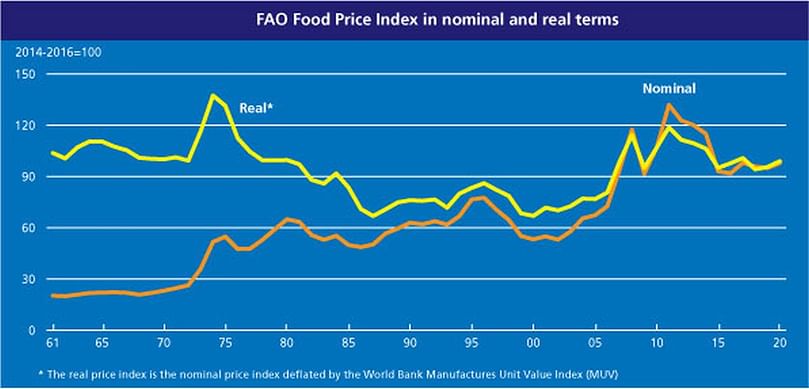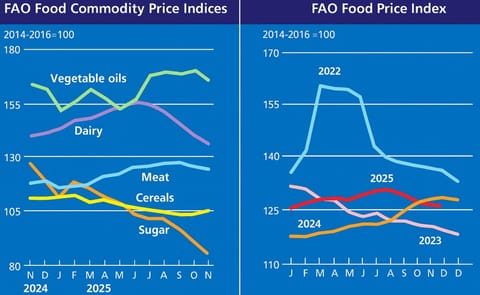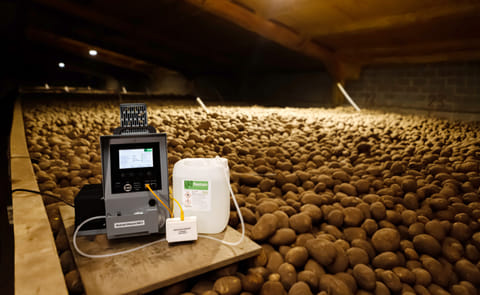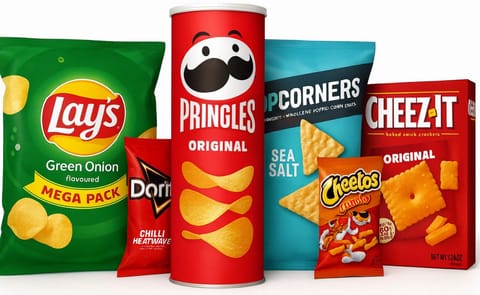FAO Food Price Index hits a three-year high in 2020, following additional gains in December
FAO Food Price Index hits a three-year high in 2020, following additional gains in December
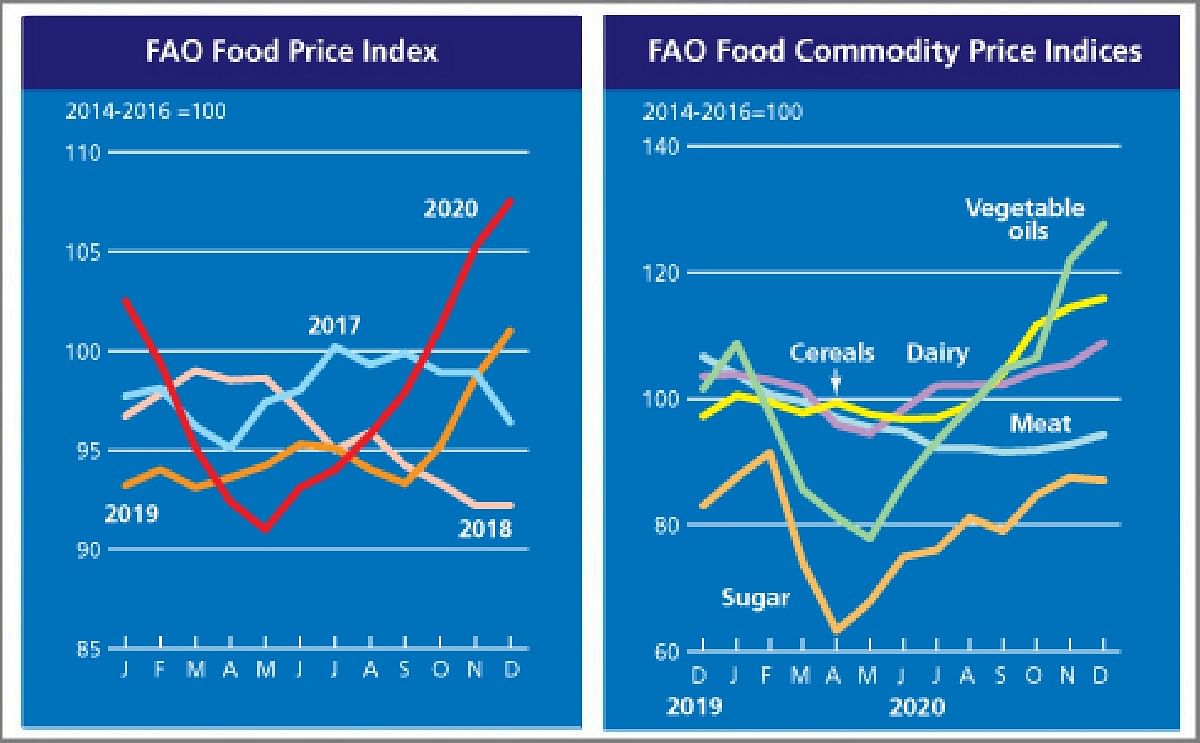
The FAO Food Price Index (FFPI) averaged 107.5 points in December 2020, up 2.3 points (2.2 percent) from November, marking the seventh month of consecutive increase.
Except for sugar, all sub-indices of the FFPI registered modest gains in December, with the sub-index of vegetable oil again rising the most, followed by that of dairy, meat, and cereals.
For 2020 as a whole, the FFPI averaged a three-year high of 97.9 points, 2.9 points (3.1 percent) higher than in 2019, but still well below its peak of 131.9 points registered in 2011.
The FAO Cereal Price Index averaged 115.7 points in December, up 1.3 points (1.1 percent) from November, marking the sixth consecutive monthly rise. Wheat export prices rose further in December, reflecting tightening supplies among major exporters, concerns over growing conditions in parts of the United States of America and the Russian Federation as well as expectations of lower than-earlier-anticipated wheat shipments from the Russian Federation following its announcement of an export tax/quota.
Among coarse grains, sorghum prices rose sharply in December, as sales from the United States of America, mostly to China, remained robust. Maize export prices moved higher, sustained by continued concerns over crop prospects in South America, with spillover from sharp increases in soybean prices adding further support.
International rice prices also rose in December, underpinned by tight Thai and Vietnamese availabilities and heightened buyer interest for Indian and Pakistani supplies.
For the year as a whole, the FAO Cereal Price Index averaged 102.7 points, up 6.4 points (6.6 percent) from the 2019 average and marking the highest annual average since 2014. Tighter supplies and stronger demand raised wheat and maize prices by 5.6 percent and 7.6 percent respectively compared to 2019.
In the case of rice, although global import demand remained lackluster in 2020, export prices rose 8.6 percent above their 2019 subdued levels to a six-year high.
The rebound was the result of production constraints in selected exporters, which were aggravated by the imposition of temporary export restrictions by some suppliers during the second quarter of the year, as well as logistical bottlenecks.
The FAO Vegetable Oil Price Index averaged 127.6 points in December, gaining 5.7 points (or 4.7 percent) month-on-month and marking the highest level since September 2012.
December's continued strength was mainly driven by firming palm oil values, while those of soy, rapeseed, and sunflower seed oil also increased. International palm oil prices rose for a seventh successive month, chiefly reflecting lingering supply tightness in major producing countries.
In addition, export flows were affected by a sharp increase in export duties in Indonesia, the world's leading palm oil supplier. As for soy oil, international prices reached seven-year highs, mainly on account of reduced export availabilities in Argentina, where prolonged strikes affected crushings and port logistics.
While rapeseed and sunflower seed oil drew strength from the firmness of the palm oil market, their prices also received support from robust global import demand. For the year as a whole, the FAO Vegetable Oil Price Index averaged 99.1 points, up 15.9 points (or 19.1 percent) from 2019 and marking a three-year high.
The FAO Dairy Price Index averaged 108.8 points in December, up 3.4 points (3.2 percent) from November and representing the seventh continuous monthly rise.
International prices of all milk products that constitute the index increased in December, underpinned by strong global import demand, mostly induced by concerns over the adverse impacts of drier and warmer weather conditions on Oceania's milk production.
High internal demand and lagging production of some milk products in Western Europe also provided support.
However, for 2020 as a whole, the FAO Dairy Price Index averaged 101.8 points, down 1.0 point (1.0 percent) from 2019.
Among the different milk products, butter prices registered the sharpest fall, followed by whole milk powder, while prices of skim milk powder and cheese increased.
The FAO Meat Price Index* averaged 94.3 points in December, up 1.6 points (1.7 percent) month-on-month, but still 12.3 points (11.6 percent) below its year-earlier value.
December marked the third consecutive monthly increase in the value of the index. Poultry meat quotations rebounded in December buoyed by a combination of increased import demand, especially from the Middle East, high internal sales in key producing countries, and the adverse production impact of avian influenza outbreaks in Europe.
Bovine and ovine meat quotations increased too, mostly on tight supplies from Oceania due to high herd-rebuilding demand.
By contrast, pig meat prices fell slightly, as exports to main Asian markets from leading European producers, especially Germany, remained suspended over African swine fever outbreaks.
For the year as a whole, the FAO Meat Price Index averaged 95.5 points, down 4.5 points (4.5 percent) from 2019. Across different meat categories, poultry meat prices registered the biggest fall, followed by those of ovine, pig, and bovine meats.
The FAO Sugar price index averaged 87.0 points in December, retreating slightly (0.5 points) from the marked increase recorded in November. The relative firmness of sugar prices was influenced by the latest trade data showing sugar imports into China, the world's second-largest sugar importer, surging by 37 percent year-on-year between January and November 2020.
Indonesia also reported increased demand for refined sugar from the food and beverage industry. On the other hand, improved production prospects in Brazil, the world's largest producer, and India, where sugar output is now expected to climb by 17 percent in 2020/21, averted any upward movements in sugar quotations.
A recent approval of export subsidies for the 2020/21 season by the Government of India put further downward pressure on prices.
For the year as a whole, the FAO Sugar Price Index averaged 79.5 points, up 0.9 points (or 1.1 percent) from 2019, reflecting a tighter world sugar market in 2020.

